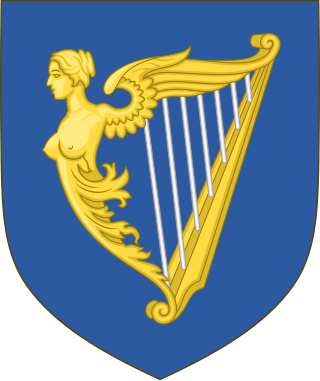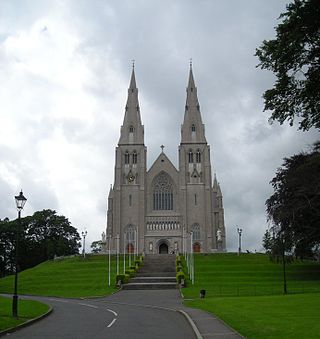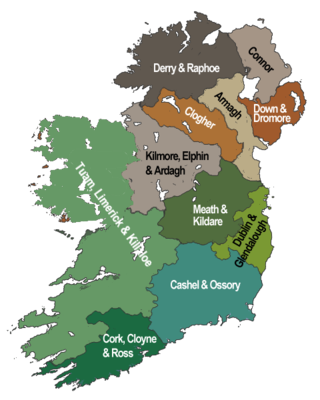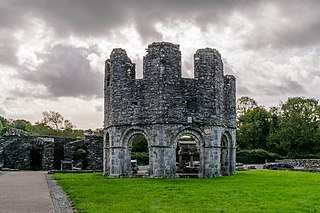Related Research Articles

The Irish House of Commons was the lower house of the Parliament of Ireland that existed from 1297 until the end of 1800. The upper house was the House of Lords. The membership of the House of Commons was directly elected, but on a highly restrictive franchise, similar to the unreformed House of Commons in contemporary Great Britain. Catholics were disqualified from sitting in the Irish parliament from 1691, even though they comprised the vast majority of the Irish population.

The Synod of Ráth Breasail was a synod of the Catholic Church in Ireland that took place in Ireland in 1111. It marked the transition of the Irish church from a monastic to a diocesan and parish-based church. Many present-day Irish dioceses trace their boundaries to decisions made at the synod.

The Dean of St Patrick's Cathedral is the senior cleric of the Protestant St Patrick's Cathedral, Dublin, elected by the chapter of the cathedral. The office was created in 1219 or 1220, by one of several charters granted to the cathedral by Archbishop Henry de Loundres between 1218 and 1220.

The Archdiocese of Armagh is a Latin ecclesiastical territory or archdiocese of the Catholic Church located in the northern part of Ireland. The ordinary is the Roman Catholic Archbishop of Armagh who is also the Metropolitan of the ecclesiastical province of Armagh and the Primate of All Ireland. The mother church is St Patrick's Cathedral. The claim of the archdiocese to pre-eminence in Ireland as the primatial see rests upon its traditional establishment by Saint Patrick circa 445. It was recognised as a metropolitan province in 1152 by the Synod of Kells.
Armagh Borough was a constituency represented in the Irish House of Commons, the house of representatives of the Kingdom of Ireland, from 1613 to 1800.

The United Provinces of Dublin and Cashel, commonly called the Province of Dublin, and also known as the Southern Province, is one of the two ecclesiastical provinces that together form the Church of Ireland; the other is the Province of Armagh. The province has existed since 1833 when the ancient Province of Dublin was merged with the Province of Cashel. Its metropolitan bishop is the Archbishop of Dublin.

The Synod of Kells took place in 1152, under the presidency of Giovanni Cardinal Paparoni, and continued the process begun at the Synod of Ráth Breasail (1111) of reforming the Irish church. The sessions were divided between the abbeys of Kells and Mellifont, and in later times the synod has been called the Synod of Kells-Mellifont and the Synod of Mellifont-Kells.

The Archdiocese of Dublin is a Latin Church ecclesiastical territory or archdiocese of the Catholic Church located in the eastern part of Ireland. Its archepiscopal see includes the republic's capital city – Dublin. The cathedral church of the archdiocese is St Mary's Pro-Cathedral. Dublin was formally recognised as a metropolitan province in 1152 by the Synod of Kells. Its second archbishop, Lorcán Ua Tuathail, is also its patron saint.

The United Dioceses of Dublin and Glendalough is a diocese of the Church of Ireland in the east of Ireland. It is headed by the Archbishop of Dublin, who is also styled the Primate of Ireland. The diocesan cathedral is Christ Church Cathedral, Dublin.
The Archbishop of Dublin is the head of the Archdiocese of Dublin in the Catholic Church, responsible for its spiritual and administrative needs. The office has existed since 1152, in succession to a regular bishopric since 1028. The archdiocese is the metropolitan see of the ecclesiastical province of Dublin, and the archbishop is also styled the Primate of Ireland. The cathedral church of the archdiocese is Saint Mary's Pro-Cathedral in Dublin city, although the Church formally claims Christ Church as its cathedral, and the archbishop's residence is Archbishop's House in Drumcondra.
The Bishop of Cashel and Ossory is the Ordinary of the United Diocese of Cashel, Waterford and Lismore with Ossory, Ferns and Leighlin in the Church of Ireland. The diocese is in the ecclesiastical province of Dublin.
In Ireland, the term city has somewhat differing meanings in Northern Ireland and the Republic of Ireland.

The United Dioceses of Cashel and Ossory is a diocese of the Church of Ireland in the south-eastern part of Ireland that was formed from a merger of older dioceses in 1977. The diocese is in the ecclesiastical province of Dublin.
The Dean of Leighlin is based at the Cathedral Church of St Laserian, Old Leighlin in the united Diocese of Cashel and Ossory within the Church of Ireland.

Irishtown is the neighborhood in Kilkenny in Ireland around St Canice's Cathedral. It was formerly a borough, also called Newcourt or St Canice's, separated by the River Breagagh from the walled town of Kilkenny to the south.

The Diocese of Tuam, Limerick and Killaloe is a diocese of the Church of Ireland that is located in the west of Ireland. The diocese was formed by a merger of the former Diocese of Tuam, Killala and Achonry and the former Diocese of Limerick and Killaloe in 2022, after the retirement of the separate dioceses' bishops and the appointment of Michael Burrows as bishop of the united diocese. It is in the ecclesiastical province of Dublin. It is one of the eleven Church of Ireland dioceses that cover the whole of Ireland. The largest diocese by area in the Church of Ireland, it covers all of counties Clare, Galway, Kerry, Limerick and Mayo, plus parts of counties Cork, Sligo, Roscommon, Offaly, Laois and Tipperary.
References
- ↑ Malcomson, A. P. W. (March 1973). "The Newtown Act of 1748: Revision and Reconstruction". Irish Historical Studies. 18 (71): 313–344, esp. p.319, fn.18 & p.328, fn.41. doi:10.1017/S0021121400025840. JSTOR 30005420.
- 1 2 Murphy, Charlotte (May–June 2010). "Peer pressure: the Irish House of Lords, 1780–1801". History Ireland. 18 (3). Retrieved 22 January 2015.
- ↑ Kowaleski-Wallace, Elizabeth (3 October 1991). Their Fathers' Daughters: Hannah More, Maria Edgeworth, and Patriarchal Complicity. Oxford University Press. p. 149. ISBN 9780195345025 . Retrieved 10 July 2017.
- ↑ "Tuam". History of the Irish Parliament. Ulster Historical Foundation. Retrieved 2 March 2014.